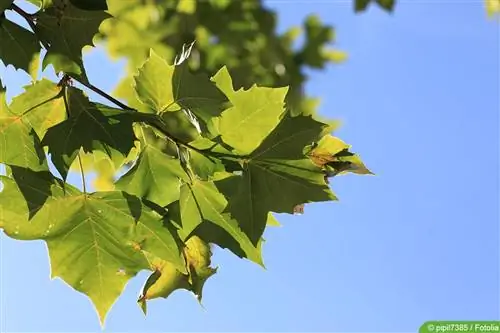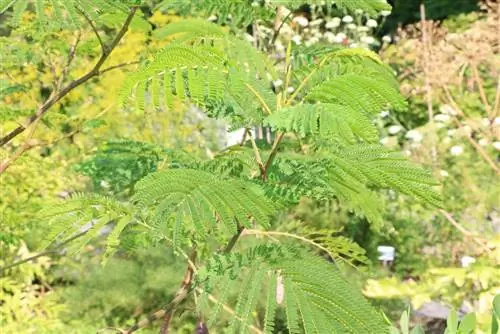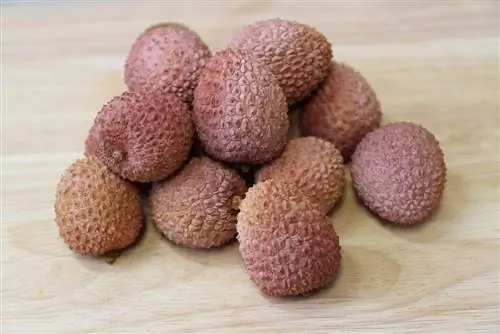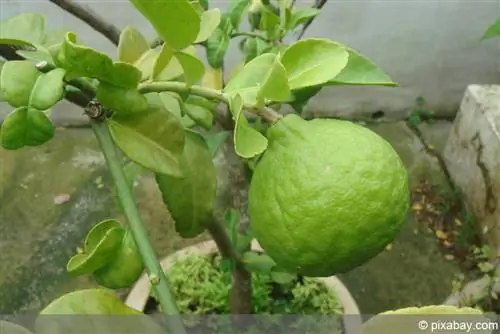- Author admin [email protected].
- Public 2023-12-17 03:39.
- Last modified 2025-06-01 06:48.
The tropical acacia tree (Acacia) is not an off-the-shelf deciduous tree that can be kept in bed with beech, ash or oak. With its evergreen foliage and lavish flowers, the exotic ornamental tree develops an unmistakable charisma. Australia pays respect to the multi-faceted species by using the golden acacia tree in its coat of arms as a symbol of its native flora. To ensure that the cold-sensitive acacia decorates your summer garden for many years, cultivation in a bucket is an option. This guide will familiarize you with the proper planting and care of an acacia tree.
Location in summer
The acacia tree is a sun-lover that even extreme summer heat doesn't cause any problems as long as the soil is sufficiently moist. When the temperatures rise in March/April, it likes to take a south-facing location in the garden in full sun. A warm location is welcome for the flowering tree, preferably surrounded by air, so that the leaves dry quickly after a rain shower.
Spring blossoms are sparser in partially shaded locations. In addition, there are long distances between the slender, dark green leaves, which gives the crown a bared look.
Tip:
With a simple trick you can give the impression that your acacia tree has been planted in the garden. To do this, dig a pit in a sunny location and place the acacia tree and its container in the ground. In late autumn, take the bucket out of the ground again and put it in the winter quarters.
Location in winter
The acacia tree can only withstand temperatures below freezing for a short time. Therefore, the exotic animal leaves the garden in late autumn and moves to winter quarters. The following options are available for a safe stay during the cold season:
- Dark and cool, with temperatures between 0 and 5 degrees Celsius
- Bright to sunny, with temperatures between 10 and 15 degrees Celsius
- Ideally with a humidity of 50 percent or more
Dark, cool wintering has the disadvantage that the naturally evergreen acacia sheds its beautiful leaves. Please only consider this winter quarters in emergencies. A bright place in a slightly temperate winter garden is better, especially since the fragrant inflorescences can be expected in early spring under these conditions. The thermometer should not exceed 15 degrees, as overwintering that is too warm can also cause leaf loss.
Substrate
Cultivation in a bucket represents a compromise solution for the cold-sensitive acacia tree because it cannot be planted in the Central European climate. Therefore, the substrate requires a high quality, beyond the potting soil from the supermarket. The better the potting soil simulates the natural soil conditions, the more vital and flowering your acacia will be.
A high-quality potted plant soil that contains an appropriate proportion of coconut fiber instead of peat meets the criteria excellently. If you enrich the substrate with lava granules or perlite breathing flakes, your acacia has no reason to complain, because structural stability and permeability are ensured.
Tips for the bucket
From the golden acacia to the umbrella acacia, the most beautiful species and varieties form a sprawling crown and a correspondingly expansive root system. Therefore, please use a suitably large container so that the above-ground and underground growth can be proportional to each other. Ideally, a pot has twice to three times the volume of the root ball.
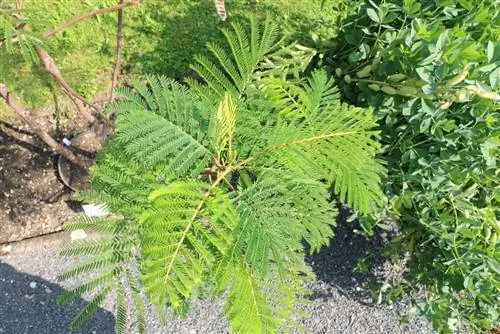
There should also be several openings in the floor so that excess irrigation and rain water can drain away. Please do not use a saucer for an acacia tree in the garden to avoid harmful waterlogging. It is better if the bucket stands on stable feet so that the roots are ventilated from below.
Plants
Container plants can basically be planted all year round. The best time to plant an acacia tree is in spring during the months of March to May. The light and temperature conditions as well as the beginning of the growing season offer the wood optimal conditions. How to plant an acacia tree correctly:
- Place the potted root ball in water until no more air bubbles appear
- Create a 3 to 5 cm high drainage on the bottom of the bucket using potsherds or grit
- Cover this water-conducting layer with an air- and water-permeable fleece
- Pour a first layer of the recommended potting soil over the drainage and press it down
- Place the potted acacia so that the root disk is a few centimeters below the edge of the pot
Water the freshly planted acacia tree thoroughly. In concrete terms, this means that you let the water run onto the root disk until it runs out of the bottom opening.
Tip:
There is disagreement among botanists, the trade and the common people about the naming of acacias. Not only the tropical, evergreen Acacia pycnantha is labeled as golden acacia, but also the hardy, deciduous locust species Robinia pseudoac. 'Frisia'. When purchasing, always ask for the botanical name to avoid such misunderstandings.
Care instructions
Immediately after planting in the pot, the first important care measure must be taken. Please do not immediately place the acacia tree in a full sunny location. To avoid irreversible sunburn of the leaves, the tree should acclimatize in a partially shaded spot for 8 to 10 days. After the successful start phase, the cultivation of your acacia culminates in the following care program:
Pouring
Estimating the ideal water balance is the biggest challenge in caring for acacias. Therefore, pay special attention to this aspect of care. The root ball must neither dry out nor become waterlogged. In both cases you will feel the displeasure of the demanding plant as large numbers of leaves fall to the ground. How to water with expertise:
- Only water when the finger test shows 1 to 2 cm of dried substrate
- Put water on the root disc until the soil at the bottom of the pot is slightly moist
- Spray the leaves with soft water every 2 to 3 days in the morning or evening
- Maintain even soil moisture even in winter
Please use mostly rainwater or stale water from the tap. Only a few acacia species can cope with high lime content. In the vast majority of subtropical and tropical ornamental trees, pH in the alkaline range causes leaf chlorosis, which leads to leaf fall.
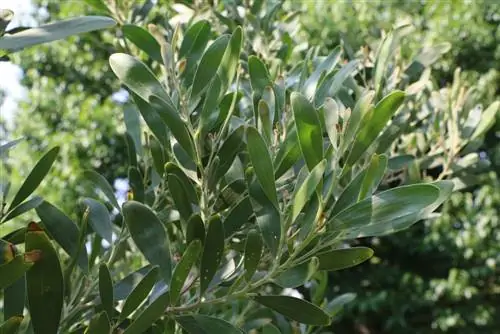
Over time you will develop a feeling for the intervals at which your acacia tree should be watered in the garden and winter quarters. Until then, a moisture meter will provide you with valuable information about the condition inside the root ball. Simple devices are powered by batteries and can be purchased inexpensively. A long sensor rod is inserted into the ground, comparable to a roasting thermometer. You can see on a scale whether the soil is wet, semi-dry or dry.
Fertilize
The dense foliage and the lavish flowers result in a high level of nutrient requirements. With a low-lime liquid fertilizer for flowering trees, energy consumption should be balanced out during the growth and flowering period. From February to September, apply adequate fertilizer every 8 to 10 days, adding it to the irrigation water. Alternatively, use a slow-release fertilizer in February and May. From October to January, stop nutrient intake.
Wintering
The modified care during the winter has already been discussed in the relevant parts of these instructions. For a better overview, the precautions during wintering are summarized here again:
- Place the acacia before the first frost in a bright winter quarters with a maximum of 15 degrees Celsius
- Continue to keep the root ball slightly moist with lime-free water
- Do not give fertilizer during wintering
- Spray the evergreen crown every few days
Please choose a location that is not in the immediate vicinity of a heating source. Please note that in bright to sunny places in the winter garden, the water requirement can increase on a daily basis. Therefore, even in winter, check the moisture content in the substrate every 2 to 3 days using a thumb test or a moisture meter.
Cutting
By pruning an acacia tree regularly and conservatively, you encourage branching. The best time for shape and maintenance pruning is immediately after flowering. Since the flowering tree produces the buds for next year's flowers in the summer, autumn is not recommended as a cutting date. This incision has proven itself in practice:
- Put on sturdy gloves to protect against the sharp thorns
- Thin out the crown by cutting dead branches onto Astring
- Remove branches growing inside the crown
- Cut off the weaker branches from branches that are too close together
- Short shoots growing out of the mold to the desired length
- Place the sharp, disinfected scissors just above a pair of leaves or a sleeping eye
If your acacia tree has shed some or all of its leaves in winter quarters, this is no reason for radical pruning. Fertilize regularly to support the growth of new leaves. You adjust the water supply to the lower consumption, as hardly any evaporation occurs when there are no leaves. Over the course of spring and early summer, the acacia puts on its foliage again. Leafless branches should only be removed if no new growth develops by summer.
Tip:
Numerous popular acacia species are not only covered in long thorns, but also contain toxins. The acacia tree is therefore not suitable for cultivation in the family garden or in the company of pets.
Pruning from bush to standard tree
A fully trained acacia tree from a specialist retailer has significantly higher acquisition costs than an acacia bush. The bargain hunters among hobby gardeners know how to take advantage of Acacia's tolerance to pruning by training a shrub into a standard tree on their own. This is how the plan works:
- Select the strongest central shoot as the trunk and tie it to a support pole
- Guide this central shoot up the rod
- Cut the trunk about 20 cm above the desired crown height
As you train the trunk to the desired height, consistently remove all competing shoots. Furthermore, cut off unnecessary side shoots along the central shoot on Astring in order to limit the crown from below.
Crown training itself depends on the type of acacia you choose. The sprawling crown of an umbrella acacia is built up in a similar way to the crown of a plane tree, in that the leading branches are given additional support for some time. In contrast, gold and silver acacias are suitable for the decorative spherical shape, which looks perfect in the pot.
Repotting
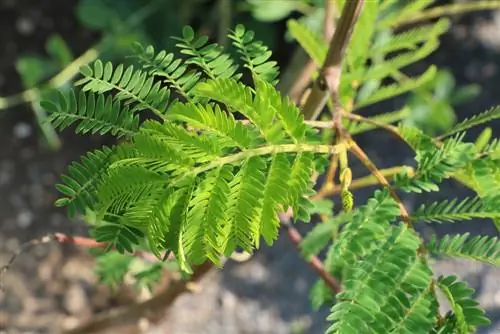
In the pot, the extensive network of roots quickly reaches its limits. Experience has shown that an acacia tree should be repotted every 1 to 2 years. The best time for this care measure is in late winter, before the growth and flowering period begins. The new bucket should have twice to three times the volume. It is important to note that the previous planting depth is maintained and the acacia can then regenerate for a week in a partially shaded location.
Propagate
If you would like more acacias of the same species, we recommend vegetative propagation using cuttings. This is how the offspring is successfully bred:
- Cut off semi-woody, non-flowering head shoots that are 10 to 15 cm long
- Remove the leaves at the bottom
- Dip the cut site in a rooting powder
- Place a cutting two-thirds of the way into a pot with moist potting soil
In the indoor greenhouse or under a transparent hood, the warm, humid microclimate promotes rooting. Keep the substrate slightly moist with lime-free water and do not apply fertilizer. To prevent mold from forming, ventilate the mini greenhouse and cover daily.
If a cutting sprouts fresh, the cap can be removed. Care for the young acacia in a partially shaded, warm place by the window or on the balcony until it has completely rooted through the growing container. Then pot your pupil in a pot and start the care program for an adult acacia.
Beautiful species and varieties
The acacia represents within the butterflies and legumes with more than 1.000 species, the largest genus. There is a correspondingly large selection for cultivating an acacia tree in the garden and winter garden. The following selection of recommended species and varieties would make your decision-making easier:
Gold Acacia (Acacia pycnantha)
The uncrowned queen of the acacias is native to Australia. With its long, narrow and evergreen leaves, the exotic beauty forms an elegant silhouette as both a shrub and a tree. The countless yellow flowers cover the branches like fragrant cotton balls.
- Flowering period: April to May/June
- Growth height in the pot: 150 to 300 cm
Silver Acacia (Acacia dealbata)
This species is considered the little sister of the golden acacia, which primarily refers to its more delicate foliage. The blue-green leaves are covered with delicate hairs that shimmer silver in the sunlight. With its yellow flower pompoms, the slender acacia attracts attention in all sunny, warm places.
- Flowering period: February/March to April/May
- Growth height in the pot: 120 to 150 cm
American Acacia - Sweet Acacia (Acacia farnesiana)
It's not just Africa and Australia that have magnificent acacias to offer. This type of acacia comes from the south of America and scores with outstanding attributes. These include the smallest leaves of all common garden acacias, paired with a seductive scent that their yellow, delicate flowers exude.
- Flowering period: April to May
- Growth height in the pot: 100 to 150 cm
Umbrella Acacia (Vachellia tortilis)
She is the character of South African savannahs. With its mighty, umbrella-like crown, this acacia species is rightly revered as a symbol of Africa. With a growth height of up to 20 meters, the acacia tree cannot be overlooked in the wild.
In Central Europe, however, the umbrella acacia in the pot remains significantly smaller. Thanks to its good-natured tolerance to pruning, the umbrella acacia is often cultivated as a bonsai.
- Flowering time: February to March/April
- Growth height in the pot: 150 to 250 cm
Conclusion
Successfully cultivating an acacia tree in the garden is linked to a variety of requirements. Since the ornamental tree comes from the tropics and subtropics, it is not hardy in Central Europe. In a large pot, the acacia can cause a sensation on the balcony, terrace or on the seat in the garden from April until the first frost. The location should be in full sun and warm so that the yellow flowers can develop. Moderate watering with soft water and weekly fertilization from February to September satisfies the demanding flower beauty. If shape and maintenance pruning is on the agenda, the best date is at the end of the flowering period. The acacia spends the winter in a bright location behind glass at temperatures of up to a maximum of 15 degrees Celsius. In all care work, the reinforcement with strong thorns and the poisonous plant sap should not be underestimated.


